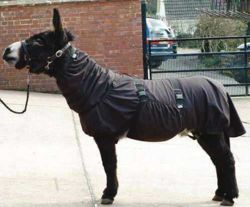Midges - Donkey
Jump to navigation
Jump to search

Donkey wearing a blanket to prevent sweet itch. (Image courtesy of The Donkey Sanctuary)
Sweet itch
This is hypersensitivity caused by flies of Culicoides spp. and a recurring seasonal problem in susceptible donkeys is common. Observations at The Donkey Sanctuary would indicate that a familial predisposition to sweet itch might exist.
Clinical Signs
Sweet itch presents as a pruritic dermatitis with lesions, usually along the dorsal surface of the donkey from neck to rump.
Treatment and control

- Control of the midges should effect a cure
- In more severe cases the use of topical antibacterial shampoos and even antibiotic and corticosteroids may be indicated
There are a number of other control measures that can be used, each with variable success.
- Avoid areas favourable for the breeding of midges, such as stagnant water, decaying vegetation and manure
- Problem fields or areas (tree cover, overgrown hedges, low lying or sheltered pastures) should be identified and avoided, and low risk areas (open windy hill tops) should be utilised
- Midges are most active at dusk and dawn so it is recommended that donkeys are stabled during this period
- Insect repellents: Deet (N,N-Diethyl-m-toluamide)
- Insecticides: 4% permethrin and benzyl benzoate (do not apply to broken or damaged skin)
- Recently Boett blankets have been used to good effect at the Donkey Sanctuary for donkeys with a history of sweet itch. The blankets are made of a special lightweight and breathable fabric that prevents midges biting. It can be used with a hood covering the ears depending on the part of the donkey affected by the sweet itch
References
- Trawford, A. and Getachew, M. (2008) Parasites In Svendsen, E.D., Duncan, J. and Hadrill, D. (2008) The Professional Handbook of the Donkey, 4th edition, Whittet Books, Chapter 6
|
|
This section was sponsored and content provided by THE DONKEY SANCTUARY |
|---|